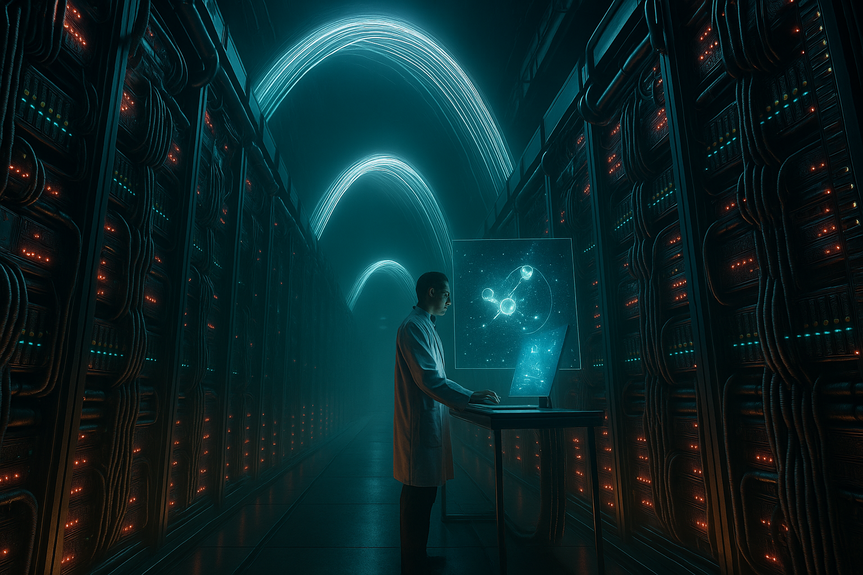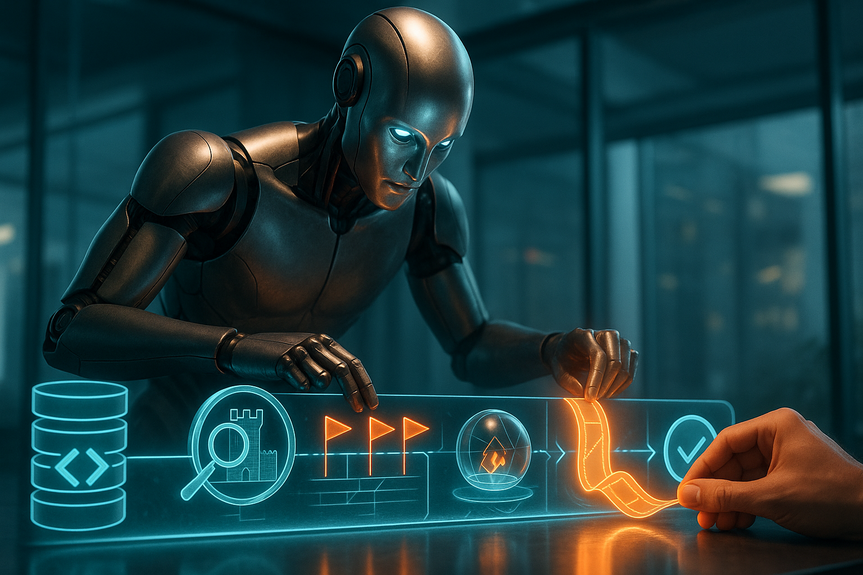DOE AI supercomputer at Argonne gives researchers 100,000 GPUs to accelerate scientific discovery.
The DOE AI supercomputer at Argonne will bring 100,000 NVIDIA Blackwell GPUs online for open science. It will speed up AI training, boost lab productivity, and tie into major U.S. facilities. Here is how this system can cut research time, improve results, and help teams move from idea to breakthrough faster.
AI for science is getting a major push. NVIDIA and Oracle will help build two new systems at Argonne National Laboratory for the U.S. Department of Energy. Solstice will use 100,000 Blackwell GPUs. Equinox will add 10,000 more. Together they will deliver up to 2,200 AI exaflops. The plan is to support open science, national security, and energy research. The systems will connect to DOE facilities and speed up model training and inference at national scale. The DOE aims to create “agentic” AI that can help scientists plan, reason, and run experiments with less delay.
Why the DOE AI supercomputer at Argonne matters right now
This project is simple to state: more compute for more discovery. The hardware scale is historic. The software stack is proven. The setting at Argonne is ideal. This combination creates a clear path from raw data to published results in months instead of years. It gives teams a shared, public resource that is built for large AI models, yet also helps smaller projects that need quick answers. In short, the DOE AI supercomputer at Argonne is designed to remove bottlenecks that block progress across biology, materials, climate, and energy.
The hardware muscle: 100,000 Blackwell GPUs and 2,200 AI exaflops
Solstice will bring a record number of NVIDIA Blackwell GPUs into one system. Equinox will add another large pool. Both systems will use NVIDIA networking to move data fast between nodes. Speed matters because modern AI models are huge and data-heavy. When you scale GPUs and networking together, training time drops, and researchers can run more experiments.
What 2,200 AI exaflops means in practice:
Train frontier language and multimodal models with more parameters and more tokens.
Run thousands of fine-tunes and ablation tests in parallel to validate results.
Move from proof-of-concept to production-grade models on the same platform.
Serve many scientific teams at once, without long queue times.
This power does not only help giant models. It also helps everyday workflows like feature extraction, simulation surrogates, and iterative inference for lab pipelines. The scale lets teams try more ideas and run more checks, which is how science improves.
From hardware to results: the software stack that makes it usable
The systems will support NVIDIA Megatron-Core for training large models. This library helps you split models and data across many GPUs. It uses tensor, pipeline, and sequence parallelism to keep utilization high. The systems will also use NVIDIA TensorRT for fast inference. Together, they form a clean path from training to serving.
How this helps you:
Use Megatron-Core to scale transformer training without custom parallel code.
Export models to TensorRT for optimized inference on the same hardware.
Run agentic workflows where trained models plan, call tools, and write reports.
Keep experiments reproducible by using a shared, stable software stack.
Agentic AI: turning models into lab co-workers
Agentic AI means models that can plan steps, call simulators, query databases, write code, and summarize outcomes. On these systems, such workflows can run at national lab speed. A typical agentic loop might:
Read a research question and search for related datasets.
Draft a plan and choose methods and tools.
Run simulations or lab-data analysis in parallel.
Score results against known metrics and report insights.
With thousands of GPUs, you can run many loops at once. Agents can compare methods, adjust parameters, and retry until they hit your target. This reduces the time from hypothesis to test to result. It also frees human researchers to focus on the new ideas that come from each cycle.
What scientists can do on day one
These systems are built to help across fields. Here are likely early wins:
Drug and protein discovery: Train large sequence models and graph networks; run fast fold prediction and docking at scale; fine-tune models on new assays.
Materials and batteries: Use foundation models to screen compounds; build surrogates for density functional theory; guide experiments to find better stability and yield.
Climate and weather: Use AI to downscale forecasts; fill data gaps; build hybrid models that mix physics and machine learning for faster runs.
Fusion and high-energy physics: Analyze imaging and sensor streams in real time; detect rare events; run agent loops to optimize beam time.
Oracle’s role: sovereign, high-performance AI with OCI
Oracle will support the build and operation with Oracle Cloud Infrastructure. The goal is to give the DOE a secure and sovereign environment that still benefits from cloud-grade reliability. This setup helps with:
Data governance and access controls for sensitive research.
Elastic scaling for bursts in training and inference.
Integrated observability for uptime, cost, and performance.
A path to bring industry partners into public-private projects.
Networking, storage, and the data pipeline
AI speed is not only about GPUs. It is about moving and feeding data. NVIDIA networking will link the systems so gradients, activations, and model shards sync fast. On the storage side, you can expect high-throughput file and object services to feed training jobs without stalls.
How to plan your data path:
Organize data in immutable, versioned buckets. Keep a data ledger with checksums.
Store raw data separate from curated, model-ready datasets.
Use shard-friendly formats (for example, Parquet or WebDataset) to stream efficiently.
Cache hot shards near the compute to avoid repeated I/O.
Log every transformation step with code, config, and seed for repeatability.
Connecting to DOE facilities like the Advanced Photon Source
Argonne will link the new systems to instruments such as the Advanced Photon Source. This lets AI sit near the data. A beamline can produce terabytes per day. With direct links, models can segment images, detect signals, and guide settings in near real time. This shortens the loop between measurement and insight.
How to prepare your team for high-scale training
Use this checklist to get ready:
Define your objective in simple, measurable terms. Example: reduce error by 10% on a held-out dataset; or cut simulation runtime by half without loss of accuracy.
Choose a baseline model and dataset that you can train on a small node first.
Profile your code with a single GPU. Fix data stalls and memory leaks.
Add mixed precision and gradient checkpointing to save memory.
Test Megatron-Core with small tensor and pipeline parallel degrees. Verify convergence.
Scale out in steps. Monitor throughput, loss curves, and validation metrics.
Save artifacts (weights, logs, configs) after every major change.
Write a short “repro guide” so teammates can rerun your jobs.
For inference at scale:
Export models with safe ops and clear input schemas.
Use TensorRT to optimize kernels and reduce latency.
A/B test outputs with ground truth or human review.
Add guardrails for prompt safety and tool access for agent flows.
Speeding up discovery: seven practical tactics
Start with synthetic data to warm up models before moving to scarce real data.
Use curriculum learning to stage training from easy to hard cases.
Adopt retrieval to keep models smaller but smarter with live context.
Build simple simulation surrogates to replace costly steps in your pipeline.
Use active learning to pick the next best samples to label or measure.
Run hyperparameter sweeps in parallel and share the top configs across teams.
Automate reporting so each run produces a clear, two-page summary with plots.
Cost, energy, and sustainability
Large AI carries energy and cost duties. You can reduce waste with:
Right-sizing jobs: do small-scale ablations before full runs.
Early stopping: track validation; stop when gains flatten.
Checkpoint reuse: fine-tune from prior weights instead of training from scratch.
Sparse methods: prune or use mixture-of-experts to cut compute per token.
Model distillation: compress big models into small, task-ready ones.
Sustainable practices help the grid and your budget. They also help more teams share the system.
Safety, security, and governance of agentic AI
Agentic systems can act. They need clear limits. Build with these steps:
Define allowed tools and data scopes. Block anything not needed for the task.
Log actions and decisions. Keep agent prompts and tool calls for audits.
Add human-in-the-loop for high-impact steps.
Use red teaming to test failure modes and harmful outputs.
Track data lineage so you can trace any result back to source and code.
These practices protect science quality and public trust.
Partnerships and the public-private model
The project uses a public-private partnership to speed buildout and bring industry use cases. This structure can turn lab methods into tools for energy grids, drug design, and manufacturing. It also brings new funding and real-world datasets into open science. The key is to keep a fair access policy, clear IP rules, and open benchmarks.
What success will look like in year one
Expect clear wins you can measure:
Queue times drop for training and inference.
More peer-reviewed papers with shared code and data.
Faster time from instrument data to publishable figures.
New foundation models for science tasks, released for community use.
Cross-lab workflows that mix simulation, data, and agent planning.
Roadmap: what’s coming and when
Equinox with 10,000 Blackwell GPUs is slated for the first half of 2026. Solstice will add 100,000 more GPUs. Early access programs will likely focus on training stability, data pipelines, and safety. Over time, the systems will support larger models, more users, and deeper links to DOE facilities. Expect regular software updates to Megatron-Core and TensorRT to improve speed and ease of use.
How to make your proposal stand out
Show a clear scientific question with a measurable target.
Present a minimal, working baseline and a scaling plan.
Include a data management plan with curation, privacy, and versioning.
Explain your validation: datasets, metrics, and error analysis.
Describe expected outputs for public sharing: code, weights, reports.
Detail safety steps for agent workflows.
This shows you will use the system well and share value back with the community.
What this means for education and workforce
The systems will support training for thousands of researchers. This is a chance to teach modern AI at scale. Students can learn parallel training, inference optimization, and data governance on real hardware. Labs can run joint courses where teams move from a small GPU to national-scale runs. This is how the next wave of AI-native scientists will grow.
The big picture is clear. A national-scale system can turn slow, one-off runs into fast, repeatable workflows. It can raise the floor of what every lab can do and push the ceiling on what is possible. The DOE AI supercomputer at Argonne is a strong step toward that future. It can turn public investment into faster cures, cleaner energy, better climate tools, and safer technology.
In the coming years, the most successful projects will mix strong science questions, clean data practices, and smart use of AI agents. They will treat compute as a precious shared tool and will publish methods that others can reproduce. If your team builds with that mindset, this new platform will meet you halfway. It will let you test more ideas, check more results, and reach breakthroughs sooner. That is how the DOE AI supercomputer at Argonne can accelerate research for everyone.
(Source: https://nvidianews.nvidia.com/news/nvidia-oracle-us-department-of-energy-ai-supercomputer-scientific-discovery)
For more news: Click Here
FAQ
Q: What is the DOE AI supercomputer at Argonne?
A: The DOE AI supercomputer at Argonne comprises two systems—Solstice and Equinox—being built at Argonne National Laboratory for the U.S. Department of Energy, with Solstice using 100,000 NVIDIA Blackwell GPUs and Equinox adding 10,000 more. Together they are intended to support open science, national security, and energy research as a shared public resource for large AI models.
Q: What hardware performance will the new systems deliver?
A: The Solstice and Equinox systems will use 100,000 and 10,000 NVIDIA Blackwell GPUs respectively and are interconnected by NVIDIA networking to deliver up to 2,200 AI exaflops of performance. This scale is designed to reduce training time and let many teams run large models and parallel experiments without long queues.
Q: Which scientific fields and workflows will benefit from the systems?
A: The systems target domains such as drug and protein discovery, materials and battery research, climate and weather modeling, and fusion and high-energy physics. They aim to accelerate tasks like large-scale model training, simulation surrogates, rapid inference, and agentic workflows that loop from hypothesis to result.
Q: What software stacks and tools will users have access to?
A: The systems will support NVIDIA Megatron-Core for distributed training and NVIDIA TensorRT for optimized inference, providing a clear path from training large transformer models to serving them efficiently. The stack is intended to help scale models, export them for inference, and enable reproducible agentic workflows.
Q: How will agentic AI function on these national-scale systems?
A: Agentic AI on the systems will run loops that read research questions, draft plans, run simulations or analyses in parallel, score results, and report insights with human oversight as needed. With thousands of GPUs available, agents can compare methods and iterate multiple times to speed the cycle from hypothesis to validated result.
Q: What are the networking, storage, and data pipeline expectations?
A: NVIDIA networking will link nodes to move gradients and model shards quickly, while high-throughput file and object storage will feed training jobs without stalls. Recommended practices from the article include organizing data in immutable, versioned buckets, using shard-friendly formats like Parquet or WebDataset, and caching hot shards near compute to avoid repeated I/O.
Q: When will researchers be able to access Equinox and Solstice?
A: Equinox, which includes 10,000 Blackwell GPUs, is expected to be available in the first half of 2026, and Solstice will bring 100,000 Blackwell GPUs under the DOE public-private partnership model. Early access programs are likely to focus on training stability, data pipelines, and safety testing according to the roadmap described.
Q: How should teams prepare proposals to use the DOE AI supercomputer at Argonne?
A: When preparing to use the DOE AI supercomputer at Argonne, teams should present a clear scientific question with measurable targets, a minimal working baseline, and a scaling plan that includes data curation, privacy, and versioning. They should also profile code on a single GPU, test Megatron-Core at small scale before scaling out, save artifacts for reproducibility, and describe safety steps for agent workflows.







